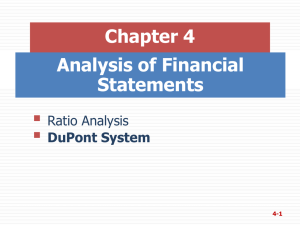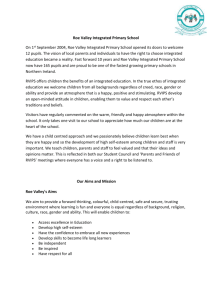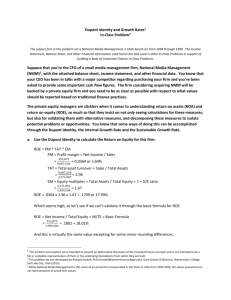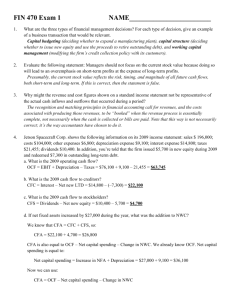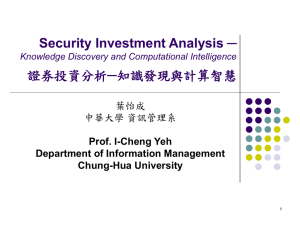comparison of profitability for pharmaceutical romanian listed
advertisement
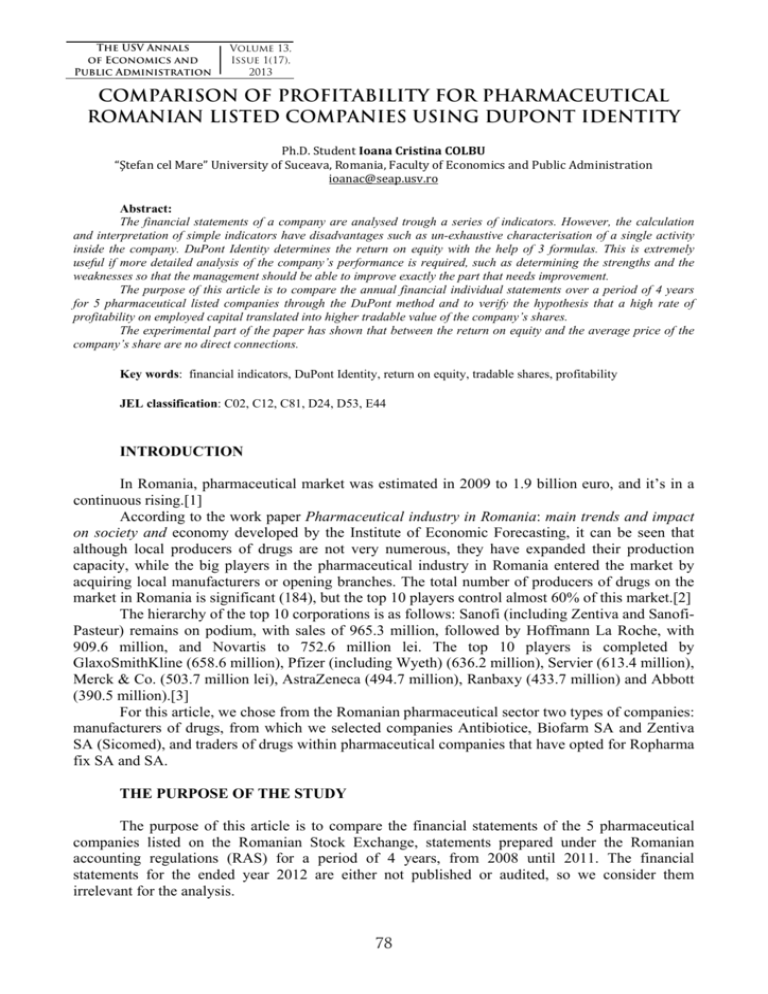
The USV Annals of Economics and Public Administration Volume 13, Issue 1(17), 2013 COMPARISON OF PROFITABILITY FOR PHARMACEUTICAL ROMANIAN LISTED COMPANIES USING DUPONT IDENTITY Ph.D.StudentIoanaCristinaCOLBU “ŞtefancelMare”UniversityofSuceava,Romania,FacultyofEconomicsandPublicAdministration ioanac@seap.usv.ro Abstract: The financial statements of a company are analysed trough a series of indicators. However, the calculation and interpretation of simple indicators have disadvantages such as un-exhaustive characterisation of a single activity inside the company. DuPont Identity determines the return on equity with the help of 3 formulas. This is extremely useful if more detailed analysis of the company’s performance is required, such as determining the strengths and the weaknesses so that the management should be able to improve exactly the part that needs improvement. The purpose of this article is to compare the annual financial individual statements over a period of 4 years for 5 pharmaceutical listed companies through the DuPont method and to verify the hypothesis that a high rate of profitability on employed capital translated into higher tradable value of the company’s shares. The experimental part of the paper has shown that between the return on equity and the average price of the company’s share are no direct connections. Key words: financial indicators, DuPont Identity, return on equity, tradable shares, profitability JEL classification: C02, C12, C81, D24, D53, E44 INTRODUCTION In Romania, pharmaceutical market was estimated in 2009 to 1.9 billion euro, and it’s in a continuous rising.[1] According to the work paper Pharmaceutical industry in Romania: main trends and impact on society and economy developed by the Institute of Economic Forecasting, it can be seen that although local producers of drugs are not very numerous, they have expanded their production capacity, while the big players in the pharmaceutical industry in Romania entered the market by acquiring local manufacturers or opening branches. The total number of producers of drugs on the market in Romania is significant (184), but the top 10 players control almost 60% of this market.[2] The hierarchy of the top 10 corporations is as follows: Sanofi (including Zentiva and SanofiPasteur) remains on podium, with sales of 965.3 million, followed by Hoffmann La Roche, with 909.6 million, and Novartis to 752.6 million lei. The top 10 players is completed by GlaxoSmithKline (658.6 million), Pfizer (including Wyeth) (636.2 million), Servier (613.4 million), Merck & Co. (503.7 million lei), AstraZeneca (494.7 million), Ranbaxy (433.7 million) and Abbott (390.5 million).[3] For this article, we chose from the Romanian pharmaceutical sector two types of companies: manufacturers of drugs, from which we selected companies Antibiotice, Biofarm SA and Zentiva SA (Sicomed), and traders of drugs within pharmaceutical companies that have opted for Ropharma fix SA and SA. THE PURPOSE OF THE STUDY The purpose of this article is to compare the financial statements of the 5 pharmaceutical companies listed on the Romanian Stock Exchange, statements prepared under the Romanian accounting regulations (RAS) for a period of 4 years, from 2008 until 2011. The financial statements for the ended year 2012 are either not published or audited, so we consider them irrelevant for the analysis. 78 Volume 13, Issue 1(17), 2013 The USV Annals of Economics and Public Administration The hypothesis from where we left was that the company with the highest average return on equity indicator (ROE) obtained in the studied period, has the highest price of share tradable on the Bucharest Stock Exchange. RESEARCH METHODOLOGY Data sources: For this study, we used secondary data. The sources of the data consist of annual and interim reports of the companies, articles, research papers and other data from the Romanian Stock Exchange (BVB) or other websites. Methods: The secondary data is collected from research articles and journals and then analyzed using statistical tools. The acquired data were processed in graphs and tables. In the case of examination of financial statements, the quantity is expressed in financial units. The category of extensive indicators includes: subtractive and state indicators [4]. Techniques for data collection and analysis: The secondary data was collected from the financial statement of the 5 companies chosen, for a period of 4 years under review. The data have been analyzed using financial ratios formulas, as well as various statistical tools and techniques. We have used as base to our conclusions the DuPont method or the DuPont Identity. Also known as the DuPont formula, DuPont analysis, DuPont Model or DuPont equation, is a method for assessing a company's return on equity (ROE) breaking its into three parts. This formula is used to discover if there are significant differences between how the performance of the company is assessed. Being perhaps one of the most important indicators of performance, DuPont formula measures operating efficiency, asset use efficiency and financial leverage. [5] The DuPont ratio can be used as a compass in this process by directing the analyst toward significant areas of strength and weakness evident in the financial statements. By analyzing each component of the ROE equation, insight is gained into whether a company’s return is based on high profitability, proficient management of assets, or leverage for risk (Smart, Megginson, & Gitman, 2007). ROE (DuPont formula) = Net profit Revenue Total assets x x Revenue Total assets Equity (1) = Net profit x Asset Turnover x Financial leverage [6] (2) Firms can be compared within an industry utilizing the DuPont analysis’s financial ratios through a cross sectional analysis or a time series basis (Ou & Penman, 1989; Eisemann, 1997; Abarbanell & Bushee 1997; Fairfield & Yohn, 2001; Milbourn & Haight, 2005; Soliman, 2008).[7] ANALYSIS: Table 1. ROE for Farmaceutical Remedia, authors’ calculations REMEDIA Company Indicator Year Net profit Asset turnover Financial leverage ROE % 2011 0.0200 1.2487 4.0904 10.23576 79 2010 0.0107 1.3489 4.9648 7.187683 2009 0.0059 1.4314 4.1955 3.571085 2008 -0.0228 1.3430 4.7005 -14.3742 Volume 13, Issue 1(17), 2013 The USV Annals of Economics and Public Administration In the year 2008, the company has registered a loss, which determined a negative ROE. For the remaining years, we can observe a constant rise of the ROE, mostly because of the uniform rate of the Financial leverage. Table 2. ROE for Antibiotice, authors’ calculations ANTIBIOTICE Company Indicator Year Net profit Asset turnover Financial leverage ROE % 2011 0.0720 0.6273 2010 0.0515 0.6203 2009 0.0542 0.5834 2008 0.0490 0.5861 1.5652 7.071352 1.4956 4.774755 1.5565 4.923808 1.4912 4.282115 The company has a low level of Net profit, but does not record loss on the analysed years. The Asset Turnover and the Financial leverage have a relatively constant level during the years. The highest value of Return on Equity is registered in 2011. Table 3. ROE for Biofarm, authors’ calculations BIOFARM Company Indicator Year Net profit Asset turnover Financial leverage ROE % 2011 0.1522 0.5053 1.2011 9.236797 2010 0.1752 0.4892 1.1542 9.889334 2009 0.2994 0.4325 1.1112 14.3913 2008 -0.3273 0.4431 1.1327 -16.4286 The values were varying during the analysed years. Net profit is the ratio which dragged down the total ROE. The lowest values appeared in 2008 and it was caused by the recorded loss of the company. On the other hand, the highest values appeared in 2009 because of a relatively high value of Net profit and Financial leverage. Table 4. ROE for Ropharma, authors’ calculations Company ROPHARMA Indicator Year Net profit Asset turnover Financial leverage ROE % 2011 0.0277 0.9918 2010 0.0309 1.2176 2009 0.0145 1.5130 2008 0.0088 2.0698 4.2576 11.71743 3.5367 13.31314 3.9239 8.58787 3.1832 5.768278 The values of the equity indicator vary during the analysed period. The highest value is recorded in 2010, where the Net profit ratio is at its highest value. 80 Volume 13, Issue 1(17), 2013 The USV Annals of Economics and Public Administration Table 5. ROE for Zentiva, authors’ calculations Company ZENTIVA Indicator Year Net profit Asset turnover Financial leverage ROE % 2011 0.1340 0.6870 2010 0.2210 0.6552 2009 -0.0164 0.5327 2008 0.1061 0.6326 1.3498 12.42276 1.1677 16.90802 1.1702 -1.02249 1.2093 8.11728 The year 2009 is an unprofitable one for the company, as it register loss and the return on equity becomes negative. The remaining period analysed are highly profitable. Table 6. Compared ROE for the 5 analyzed companies, author’s calculations Company Year ROE Remedia ROE Antibiotice ROE Biofarm ROE Ropharm ROE Zentiva 2011 10.23576 7.071352 9.236797 11.71743 12.42276 2010 7.187683 4.774755 9.889334 13.31314 16.90802 2009 3.571085 4.923808 14.3913 8.58787 -1.02249 2008 -14.3742 4.282115 -16.4286 5.768278 8.11728 Average ROE 1.655087883 5.263007372 4.272202242 9.846678723 9.10639171 Analysing Table 6, we can say that Ropharm is the average most profitable company, in the given period, with a return on investment of almost 10% [8]. 12 9.846678723 10 9.10639171 8 6 5.263007372 4.272202242 4 2 1.655087883 0 Remedia Antibiotice Biofarm Ropharm Zentiva Chart 1. ROE for the chosen companies – absolute values So, if the initial hypothesis in correct, the highest average value of tradable shares should be Ropharm’s, followed by Zentiva and Antibiotice. Summarizing data collected from the Bucharest Stock Exchange website, the following average prices for 52 weeks results: 81 Volume 13, Issue 1(17), 2013 The USV Annals of Economics and Public Administration 0.9 0.7786 0.8 0.7 0.639 0.6 0.5 0.3984 0.4 0.3 0.2678 0.199 0.2 0.1 0 Remedia Antibiotice Biofarm Ropharma Zentiva Chart 2. Average price for 52 weeks Source: http://www.bvb.ro/TradingAndStatistics/Preturi52sapt.aspx We can observe that the highest average price for a share is Zentiva’s, followed by Ropharma and Antibiotice. CONCLUSION In this paper, we have tried to determine with the help of profitability ratios like ROE, analyzing the correlations between the net income, the asset turnover and the leverage, if the companies’ share price are relevant to investors, once compared with the return on equity. Our study demonstrated that in terms of price per share, the investors are not directly influenced by the return on equity of analyzed companies. As a conclusion, the DuPont analysis that we made by calculating Net profit, Assets turnover or ROE for the 5 companies chosen, emphasize that absolute measurements are not relevant every time. Therefore, to have a common basis of comparison between several sets of data is necessary when calculating the ratio between effect and effort, but not relevant enough for connecting profitability with price per share. “ACKNOWLEDGMENT This paper has been financially supported within the project entitled „Doctorate: an Attractive Research Career”, contract number POSDRU/107/1.5/S/77946, co-financed by European Social Fund through Sectoral Operational Programme for Human Resources Development 2007-2013. Investing in people!” ENDNOTES [1] http://www.money.ro/industria-farma-a-concediat-in-2009-un-om-din-zece_430576.html [2] http://oglindadevest.ro/wp-content/uploads/2012/03/Industria-farmaceutica-in-Romania.pdf [3] http://www.capital.ro/detalii-articole/stiri/top-10-companii-farmaceutice-din-romania-174918.html [4] Subtractive indicators show the variation of state of given groups of assets or liabilities which are always applied to the same time. State indicators present the state of property and its financial resources of cover to the given time. (Zálešáková J., Financial Analysis of D H J – Kovo, s.r.o., 2010) [5] http://www.money-zine.com/Investing/Investing/DuPont-Equation/ [6] Eagle, D., Djatej, A., The Percent-Change Extension to the DuPont Identity, Asian Journal of Finance & Accounting, 2012, Vol. 4, No. 2, www.macrothink.org/ajfa [7] Pellika J.R.K., Comparing lodging REITs using DuPont analysis: Evaluating shareholder equity, http://digitalscholarship.unlv.edu/thesesdissertations [8] The average ROE has been around 10% to 12%. 82 The USV Annals of Economics and Public Administration Volume 13, Issue 1(17), 2013 REFERENCES 1. Almazari A. A., Financial Performance Analysis of the Jordanian Arab Bank by Using the DuPont System of Financial Analysis, www.ccsenet.org/ijef International Journal of Economics and Finance Vol. 4, No. 4; April 2012 2. Herciu M., Ogrean C., Belascu L., A Du Pont Analysis of the 20 Most Profitable Companies in the World, 2010 International Conference on Business and Economics Research, vol.1 (2011) © (2011) IACSIT Press, Kuala Lumpur, Malaysia 3. http://peregrin.jmu.edu/~drakepp/investments/modules/module8.pdf 4. http://www.businessmagazin.ro/analize/industrie/medicamente-made-in-romania-cine-suntmarii-producatori-7909061/?p=1 5. http://www.capital.ro/detalii-articole/stiri/top-10-companii-farmaceutice-din-romania174918.html 6. Isberg, S. C., Financial Analysis with the DuPont Ratio: A Useful Compass, The Credit and Financial Management Review 7. Pellika J.R.K., Comparing lodging REITs using DuPont analysis: Evaluating shareholder equity, http://digitalscholarship.unlv.edu/thesesdissertations 8. Soliman, M. T., Using Industry-Adjusted DuPont Analysis to Predict Future Profitability, Stanford University 2004 9. www.investorsfriend.com 10. Zanjirdar M., Seifi M., Review of relationship between dividend policy and performance: Evidence of Iran's capital market, African Journal of Business Management Vol. 6(40), pp. 10507 10513, 10 October, 2012, available online at http://www.academicjournals.org/AJBM 83
